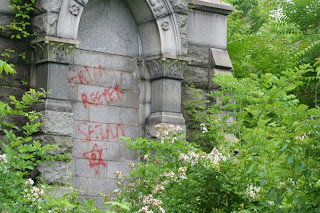In the early 2000s, it occurred to me that I should revisit certain local cemeteries during different seasons. Wind and rain wear down the statues, moss and lichens grow on the marble, and snow tends to create a whole new mood. So over a year's time, the statues have worn. Seasonal changes tend to affect the character of the statues--for example, autumn leaves surrounding the architecture or wet granite during a rain.
One snowy and frigid day I took my car to the local cemetery to shoot for a while. It was so cold that I would keep the car's engine on and the heater blasting, run out into the cemetery with an umbrella to keep the falling snow off the camera lens and shoot for a few minutes until my fingers went numb. Then I'd plod back through the drifts to the car, jump in and hold my aching fingers over the hot air vents.
I did this a few times until finally, on returning to the running car, I realized I'd locked myself out!
Panic builds character, but survival has a greater payoff. This was in the days before cell phones, so I trudged my way through the cemetery and down the street to a laundromat, where I called AAA from a pay phone. Ever call AAA for roadside assistance? They want to know where to find you. It was a little embarassing --"Well, I'm near the intersection of Azalea Path and Orchis Lane, near the Halcyon Lake." Long story short, I'd maxed out the annual towing rider on my Saab, but they did allow me this one "lock out" visit as part of my plan.
The image you see above is from this cemetery, Holy Cross in Yeadon, PA. I really like the snow falling on the statues. This cemetery bordering Southwest Philadelphia is most resplendent with angelic stone figures, more so than any cemetery in the entire city. You'd have to go to Baltimore to find one that was better stocked.
One snowy and frigid day I took my car to the local cemetery to shoot for a while. It was so cold that I would keep the car's engine on and the heater blasting, run out into the cemetery with an umbrella to keep the falling snow off the camera lens and shoot for a few minutes until my fingers went numb. Then I'd plod back through the drifts to the car, jump in and hold my aching fingers over the hot air vents.
I did this a few times until finally, on returning to the running car, I realized I'd locked myself out!
Panic builds character, but survival has a greater payoff. This was in the days before cell phones, so I trudged my way through the cemetery and down the street to a laundromat, where I called AAA from a pay phone. Ever call AAA for roadside assistance? They want to know where to find you. It was a little embarassing --"Well, I'm near the intersection of Azalea Path and Orchis Lane, near the Halcyon Lake." Long story short, I'd maxed out the annual towing rider on my Saab, but they did allow me this one "lock out" visit as part of my plan.
The image you see above is from this cemetery, Holy Cross in Yeadon, PA. I really like the snow falling on the statues. This cemetery bordering Southwest Philadelphia is most resplendent with angelic stone figures, more so than any cemetery in the entire city. You'd have to go to Baltimore to find one that was better stocked.

















